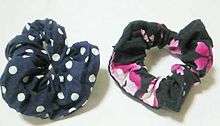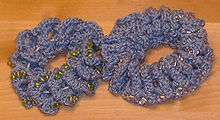Scrunchie
A scrunchie (or scrunchy) is a fabric covered elastic hair tie used to fasten medium to long hair types.[1] Large, elaborate styles and diminutive, unassuming forms are available in many different colors, fabrics, and designs.[2] Although scrunchies are most commonly used in hair, they can also be worn around the wrist or ankle as an accessory to enhance an outfit.


History
The Scrunchie was patented in 1987[3] by Rommy Revson. She created the first prototype of the Scrunchie because she wanted a gentler version of the metal hair ties used in the 1980s.[4] Revson named the decorative hair accessory the Scunci after her pet toy poodle.[5] The name Scrunchie was a natural evolution, because the fabric scrunched up. After patenting the Scrunchie, Revson spent most of her time in legal disputes, both with manufacturers and her own lawyers.[6] Scrunchies were particularly popular in the 1980s and 1990s, including larger, more elaborate versions. Scrunchies regained popularity in the mid 2010s.[7]
Popularity
Revson's Scrunchies were extremely popular in the 1980s and 1990s. Scrunchies initially became popular in the 80s because they were a less damaging alternative for pulling big hair up.[8] Also, scrunchies came in many different colors and patterns, so they matched the colorful and over-the-top aesthetic of the 1980s. Well-known celebrities such as Janet Jackson, Paula Abdul, Demi Moore, and Sarah Jessica Parker were all seen wearing them.[4] Debbie Gibson in particular wore them; Madonna wore a large velvet scrunchie in Desperately Seeking Susan.[9] Scrunchies were also featured in popular movies like Heathers, being passed from one Heather to another based on popularity shifts.[10] The popularity of scrunchies continued into the 1990s as well. This time, scrunchies made an appearance in shows such as Friends, Full House, and Seinfeld.[4] However, scrunchie popularity was not limited to celebrities and television; many female astronauts used them to secure their hair while they were on a mission.[4]
The early 2000s marked a downfall in the popularity of scrunchies. Carrie Bradshaw in an episode of Sex and the City mocked the fashion.[2][7][11] This comment represented the decline in popularity of the scrunchie during this time period. The scrunchie became a faux pas in the sense that wearing it around was embarrassing.[4] Many people believed that scrunchies should stay in the past.
Even after its downfall, the scrunchie still made a comeback. In the late 2010s it was seen all over runways and in the hair and on the wrists of celebrities.[12] Famous women such as Hailey Bieber, Bella Hadid, Gigi Hadid, and Selena Gomez have all been seen wearing them again.[4] Famous singer Lizzo generated news when she wore a $100 scruchie with jewels on it backstage at MTV's Video Music Awards.[12] It was featured in the popular Netflix original movie To All the Boys I've Loved Before as a symbol of power struggle between main character Lara Jean and her former BFF[10] and the character Eleven on Stranger Things was seen wearing them in the third season of the show in 2019.[8]
Scrunchies are also an integral part of the VSCO girl aesthetic, which is a specific trend from the app VSCO that is discussed greatly on another app called TikTok.[8] The re-surge in popularity is partly attributed to the rise in nostalgic culture at the end of the 2010s.[8] Another reason cited for its rise in popularity in the late 2010s is an increased emphasis on hair health, the scrunchie is gentler on curly, coarse, or kinkier hair than normal hair ties.[12]
Types and variations
There are over five hundred different designs of scrunchies since its invention.[4] There are many different brands and stores that sell them.[4] In the US, almost every major store sold some sort of scrunchie in 2019. The Scünci brand offers a range of textures, including velvet, satin, and fur, as well as various designs such as neon and metallic.[4] There are also different variations of the scrunchie. There is a scrunchie bow, which is a normal scrunchie with a small and short or large and long bow on one side of it.[13] There are also different patterns, such as leopard print, tie-dye, and dotted. There are also scrunchies with prints of animals or pictures of flowers on them.[13] Overall, there are hundreds of different designs of scrunchies. The size of scrunchies also varies, ranging from as small as a normal hair tie to the over-sized scrunchie that is as big as the back of the head.
References
- "Scrunchie". Merriam-Webster online.
- Marissa Gold (January 28, 2010). "Hair Scrunchies, Explained – Scrunchie 101". StyleList. Archived from the original on August 22, 2011.
- US Patent #USS1D0292030, United States Patent and Trademark Office
- Granero, Kristin (August 28, 2019). "Everything You Need to Know About the History of the Scrunchie". PureWow. Retrieved February 7, 2020.
- "The inventor of the scrunchie had a second idea that was even weirder". Trivia Happy. Retrieved December 10, 2018.
- "Lawyer, Scunci Queen Tangle Over Legal Fees". Observer. April 19, 1999. Retrieved December 10, 2018.
- Heather Schwedel, "Fight to the Decades: Are We Experiencing an ’80s or ’90s Comeback?", Flavorwire, August 25, 2009.
- Radin, Sara. "How Scrunchies Became the Biggest Fashion Trend — Again". Teen Vogue. Retrieved February 7, 2020.
- Mhairi Graham, "The Scrunchie Revival: AnOther considers the return of that 90's classic – the scrunchie", AnOther, May 29, 2014.
- Hart, Maria Teresa (November 1, 2019). "How the scrunchie rose and fell and rose again in popularity". Vox. Retrieved February 7, 2020.
- Sex and the City Episode 78: "Pick-A-Little, Talk-A-Little", HBO, retrieved March 23, 2016.
- Selyukh, Alina (December 16, 2019). "Scrunchies Are Cool Again. Hair's How They Staged A Comeback". NPR. Retrieved February 7, 2020.
- DuBois, Elizabeth (June 4, 2019). "I Can't Stop Buying Unusual Scrunchies". The Strategist. Retrieved February 7, 2020.